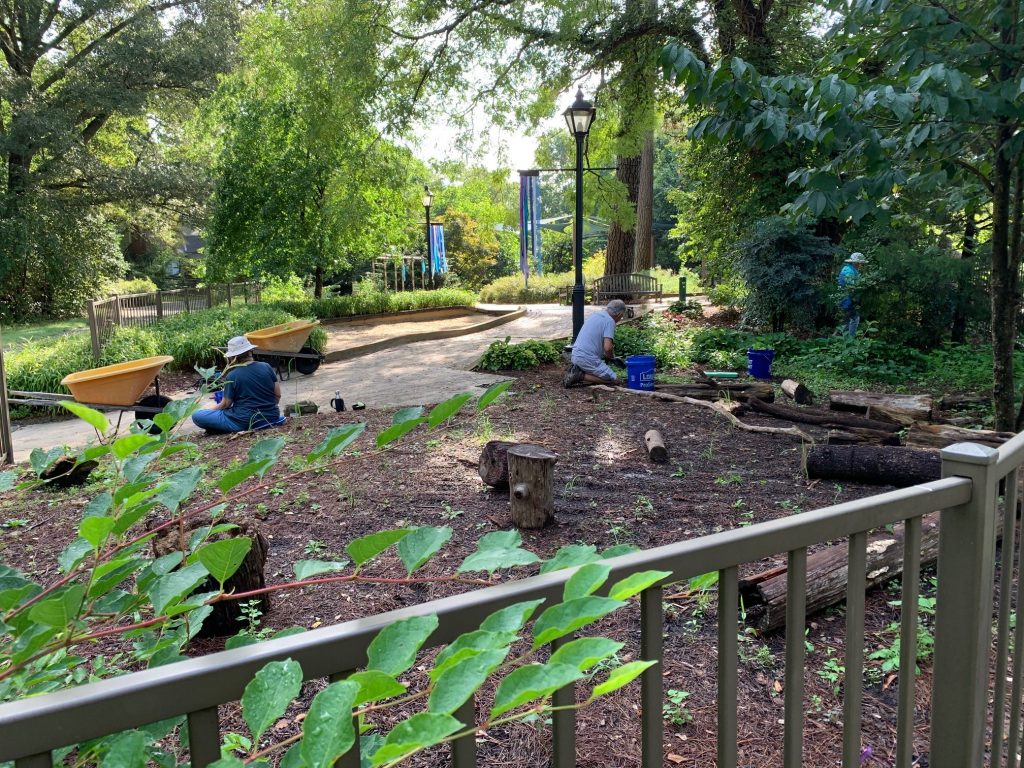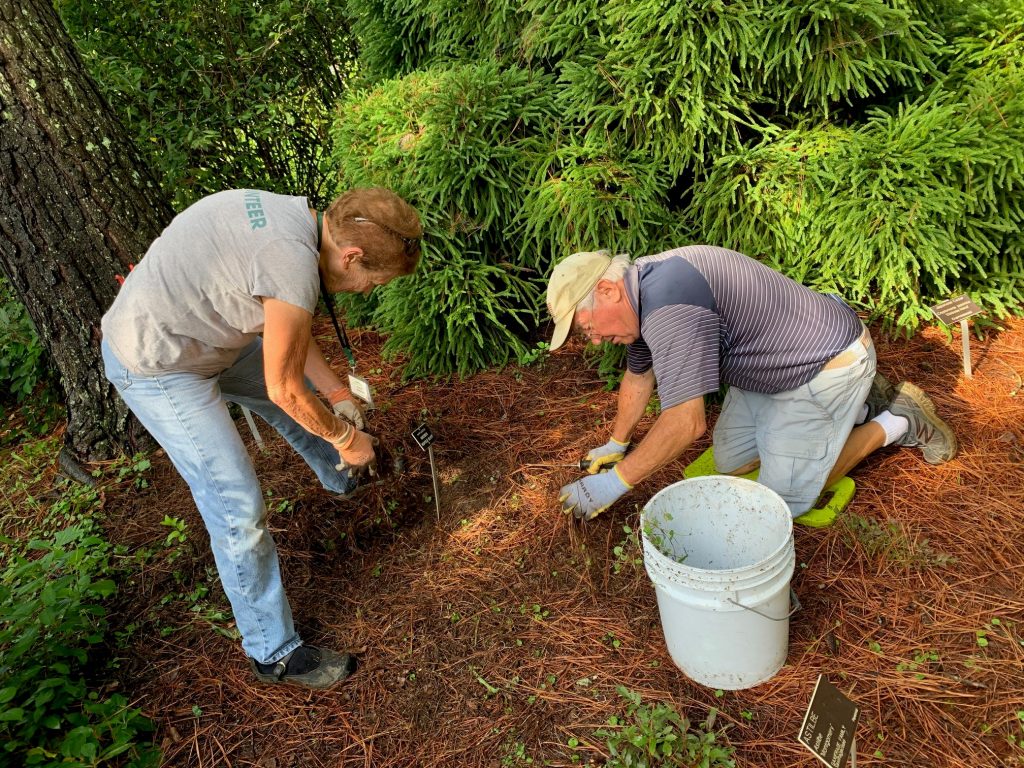Volunteers Making a Difference Gardening
“The Garden would be a jungle without them,” says Senior Horticulturist Elizabeth Fogel, the gratitude in her voice infused with respect and relief. “Or overrun with weeds, for sure. They’re absolutely indispensable.” She’s talking about the 37 teams of volunteers who work alongside her and her seven fellow horticulturists every week, caring for the 50 cultivated acres of Lewis Ginter Botanical Garden and really making a difference. “It’s an honor to work with them,” agrees Senior Horticulturist Shannon Smith. “Keeping the Garden as well-groomed as it is without the volunteers would be impossible.”
For at least 24 years now, but longer than anyone can remember, teams of six to eight adults have shown up every week on their assigned day, ready to weed, rake, prune, plant, transplant, mulch, fertilize and water. Each team is paired with a particular horticulturist and dedicated to caring for a specific section of the Garden. They prefer to bring their own gloves and hand tools — a favorite pair of pruning shears or an indispensable garden knife. Large tools are delivered to the work site by Garden staff. Many of the volunteers have earned their Master Gardener or Master Naturalist certification. Most of them just love to garden.
They work in the cold, in the rain and in the heat and humidity of a Virginia summer. “We may be small, but we’re mighty,” volunteer Susan Bateman declares.
“They’re willing to do the real grunt work, not just the glamour jobs,” Fogel says about the unflagging dedication she sees in her team. Their commitment to the Garden eclipses even the tedium of pulling weeds. “I do try to keep them out of harm’s way,” she confides. When the beloved female ginkgo tree in Grace Arents Garden is in season, it can drop 35 gallons of repugnant round fruit on the lawn in one day, fruit that contains urushiol, the chemical in poison ivy that causes blisters and itching.
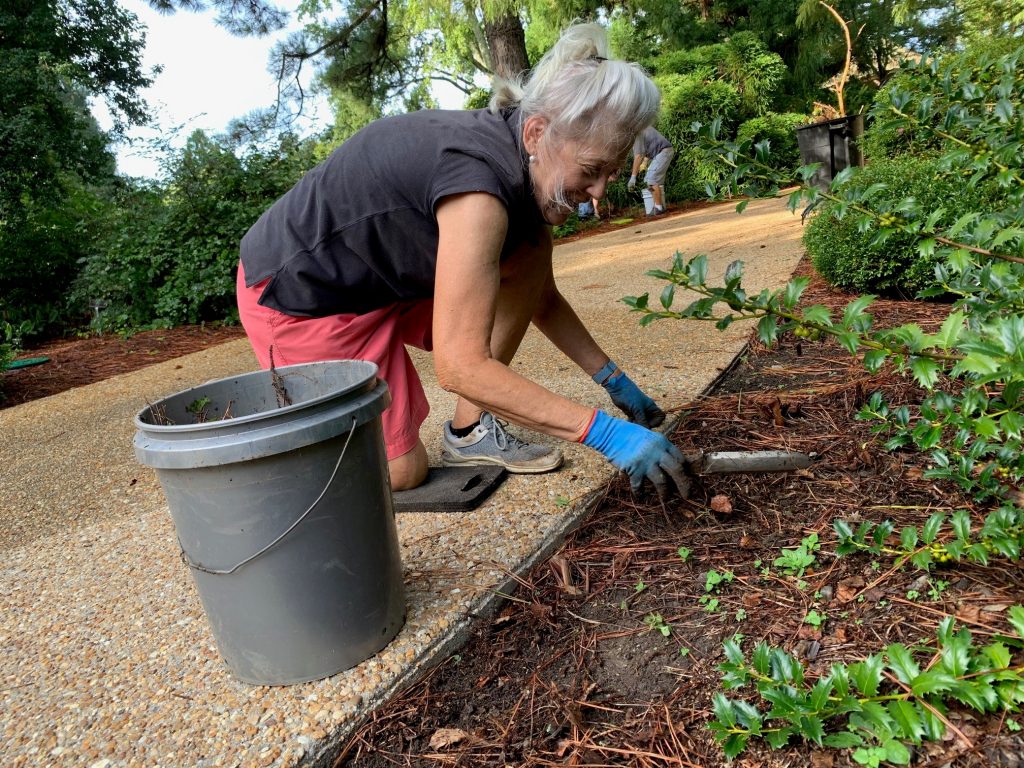
The Tuesday morning volunteers tend to be all smiles, even when they are working hard in the heat. Here’s Judy Gilman plugging away.
Fogel tries to gather the fruit herself as much as possible because it’s not fun. Even so, both she and Batemen have been hit on the head by falling fruit as they crawled around on their hands and knees under the tree. “When the fruit is hard and green, it hurts” she laughs. “But when it’s ripe, it just goes squish and then you smell bad for the rest of the day.”
Often, the volunteers are retired, having given up their home gardens for the convenience of life in a maintenance-free senior living community. At Lewis Ginter, their passion for plants has found a new place to grow. “We have the time to do this,” Wanda Atkinson acknowledges. “Besides, being in the dirt is the best way to get grounded.” It can be therapeutic, this time spent together, working outdoors. She confesses to taking out her aggression on the weeds.
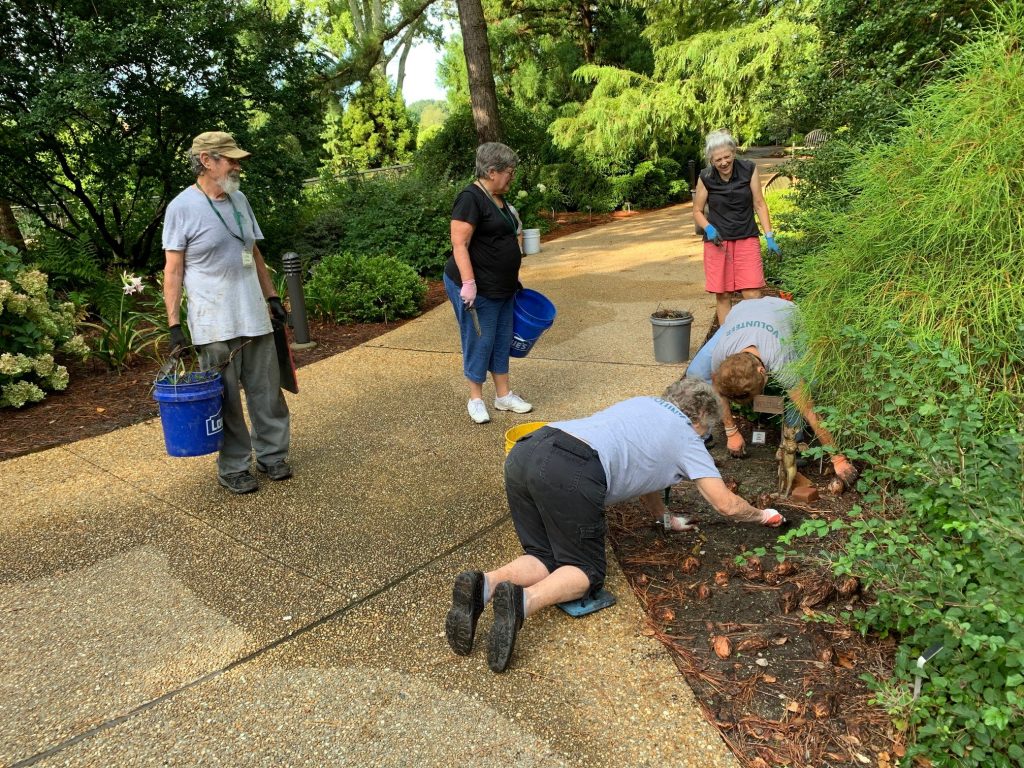
Volunteers (clockwise) Joe Terry, Leslie Munson, Judy Gilman, Susan Bateman and Clara Spicer (kneeling) weeding in the Children’s Garden.
Atkinson also beams with pride when she talks about the Children’s Garden where she has volunteered every week for four years. “When my friends visit, I tell them, ‘Come with me to my garden,’” she says. The volunteers have a strong sense of ownership that has evolved out of their time spent volunteering here. Many admit to stopping to pick up a stray piece of trash they may find as they walk to their car at the end of a workday. While we talk, volunteer Barb Sawyer bends over to pull a weed. “It’s hard to fight the urge,” she says, acknowledging the power of her commitment.
Making a Difference
When volunteers interact with guests, volunteers become the Garden’s unofficial ambassadors. “Visitors will stop to ask us for directions but stay to learn something,” Barb nods, confirming what many of her team members have experienced. “Milkweed and monarchs are big conversation starters. Questions from children are the best. Kids want to know why we are pulling up ‘those flowers’ (weeds, usually, or plants growing where we don’t want them.) Or they’ll say ‘I grow that in my garden at home.’ We show them a butterfly or chrysalis we’ve discovered. Or explain about good bugs and bad bugs.” Guests often make a point to thank them for the work they’re doing. “Parents are especially grateful when we engage with a curious child,” Barb Sawyer smiles. They are making a difference.
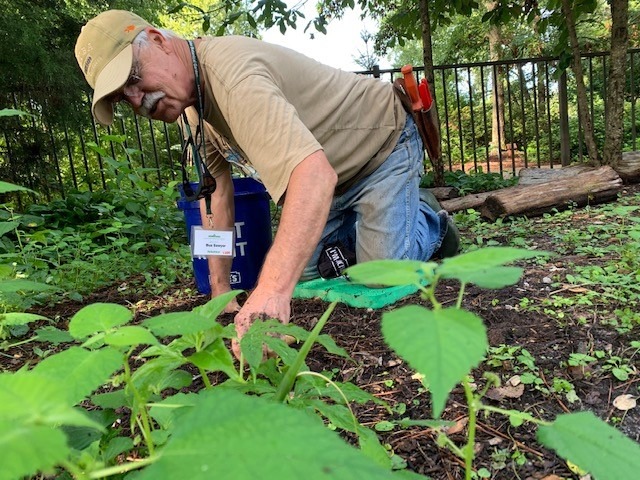
Volunteer Buz Sawyer volunteers multiple days a week in a variety of capacities and often in the Children’s Garden.
Volunteer Buz Sawyers’ favorite story is about a pair of little girls who sat down on the ramp to the Klaus Family Treehouse to watch him prune a dogwood. Eventually, one of them asked him if he was a plant doctor. “So, I said, ‘Well I guess I am!’ She smiled at me, looked knowingly at her friend, and off they went. By the way, the tree survived the surgery,” he grins.
The Garden’s horticulturists love to share their knowledge with the volunteers who work with them. Uprooting English ivy can turn into an exercise in identifying and eradicating invasive species. They have been introduced to new plants, discovered the benefits of companion planting, learned when and how to prune a variety of trees and shrubs, and mastered the correct planting depth for different flowering bulbs. “Today we got a lesson about chiggers,” volunteer (and former Garden staffer) Martha Anne Ellis says, her pants legs tucked into her socks. It’s a fashion risk she’s willing to take to outwit the irritating little insects.
And there are lessons learned the hard way, like the day that both Sook Rinaldi and Clara Spicer learned what poison ivy looks like. Or the time a few years ago when Sawyer and a well-meaning accomplice punctured an irrigation line in the Children’s Garden while installing new herb beds. “A small geyser bubbled up about a foot or so and we managed to flood quite an area before we figured out how to turn the water off,” he confesses.
Over the years, each group has developed its own traditions. They celebrate birthdays, tour each other’s home gardens and share plant cuttings, bring meals to someone who is under the weather, trade recipes at an annual Christmas cookie exchange and banter good-naturedly about politics. Several of them have traveled abroad together. “I should pay to work here,” Rinaldi laughs, “I love it so much.”
Out of their abiding love for the Garden, lasting friendships have grown. Their hope is to grow in numbers, as well. “We want our legacy to live on,” Bateman says, speaking for the group about inspiring new others to join them.
Visit our website to learn how you can become one of the 350 active volunteers making a difference. We’d love to have you.
VOLUNTEER BENEFITS
After volunteers earn 100 hours of service (60 hours in the last calendar year) they qualify for the following benefits in the next calendar year:
- 15% discount in the Garden Shop
- 15% discount in the Garden Cafe
- 20% discount on gift memberships
- 15% discount on Facility Rental
- Free registration for classes on a standby basis (Does not include supply fees, if required)
- 1-year Lewis Ginter Botanical Garden membership — at your request
